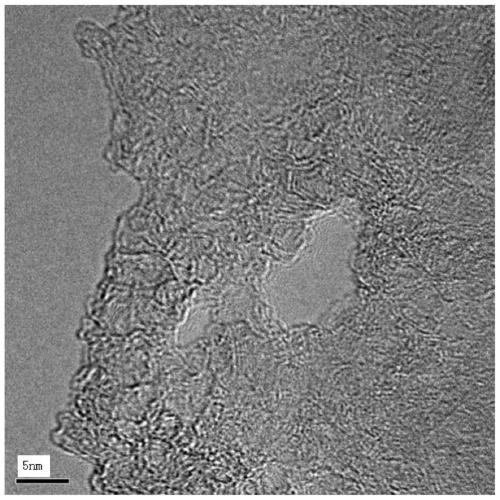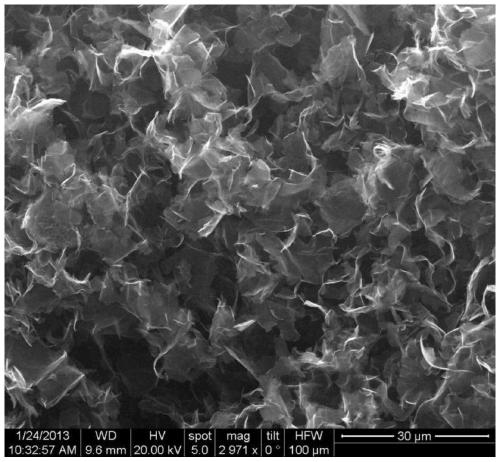Porous ultra-thin graphene suitable for lubricating oils and preparation method and application thereof
A graphene and graphite technology, applied in the field of porous ultra-thin graphene and its preparation, can solve the problems of uneven cleavage, thick graphene thickness and small size
- Summary
- Abstract
- Description
- Claims
- Application Information
AI Technical Summary
Problems solved by technology
Method used
Image
Examples
Embodiment 1
[0043] 1. Mix 1 part by mass of graphite, 1 part by mass of concentrated sulfuric acid, and 0.1 part by mass of hydrogen peroxide, heat to 30°C and stir for 1 hour to conduct weak oxidation experiments on the edge of graphite;
[0044] 2. Add 15 parts by mass of pure water. The concentrated sulfuric acid in step 1 will play a role again after being diluted by pure water in this step to promote the intercalation of water molecules. Because of the addition of concentrated sulfuric acid in step 1, no additional addition is required here For strong acid or strong base, heat the obtained mixture to 200°C in a closed manner, and control the pressure below 10 MPa through a pressure reducing valve, and react for 24 hours to conduct water molecule intercalation experiments;
[0045] 3. Wash the obtained mixture to neutrality, then freeze it in the refrigerator at -20°C for more than 5 hours, and then vacuum-dry the obtained mixture until the surface is dry, and the water-intercalated gr...
Embodiment 2
[0049] 1. Mix 1 part by mass of graphite with 2 parts by mass of hydrogen peroxide, heat to 30°C and stir for 1 hour to conduct a weak oxidation experiment on the edge of the graphite. After oxidation, wash and dry the remaining hydrogen peroxide in the system; here is the reason for washing and drying the hydrogen peroxide The reason is that the hydrogen peroxide content in this system is relatively high, if it is not washed and dried, there will be a risk of explosion.
[0050] 2. Add a dilute phosphoric acid solution with a pH of less than 1 (adjust the concentration of phosphoric acid by controlling the pH), heat the resulting mixture to 200°C in a closed manner, and control the pressure below 10 MPa through a pressure reducing valve, and react for 24 hours. Intercalation experiment.
[0051] After the successful intercalation of water molecules, steps 3-5 are exactly the same as in Example 1, and the prepared graphene scanning electron microscope is as follows figure 2 ...
Embodiment 3
[0053] Only in the weak oxidation process, graphite powder is pressed into a block with a certain mechanical strength as an electrode, which is connected to the positive electrode of the power supply, and the platinum electrode is used as the counter electrode, and the platinum electrode is connected to the negative electrode of the power supply, and the two electrodes are placed in dilute sulfuric acid aqueous solution. The voltage is 1V, react until the graphite electrodes all fall off, then wash the fallen graphite and dry it. Continue to follow-up steps 2-5, and the remaining follow-up steps 2-5 are the same as in embodiment 2.
PUM
 Login to View More
Login to View More Abstract
Description
Claims
Application Information
 Login to View More
Login to View More - R&D
- Intellectual Property
- Life Sciences
- Materials
- Tech Scout
- Unparalleled Data Quality
- Higher Quality Content
- 60% Fewer Hallucinations
Browse by: Latest US Patents, China's latest patents, Technical Efficacy Thesaurus, Application Domain, Technology Topic, Popular Technical Reports.
© 2025 PatSnap. All rights reserved.Legal|Privacy policy|Modern Slavery Act Transparency Statement|Sitemap|About US| Contact US: help@patsnap.com



